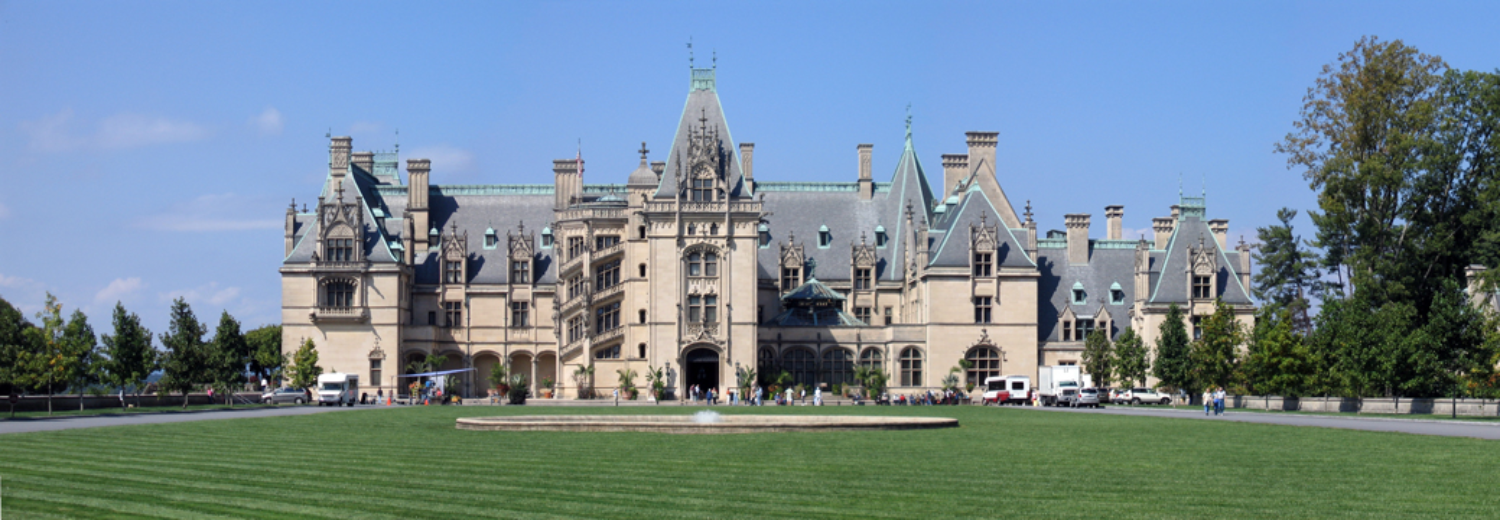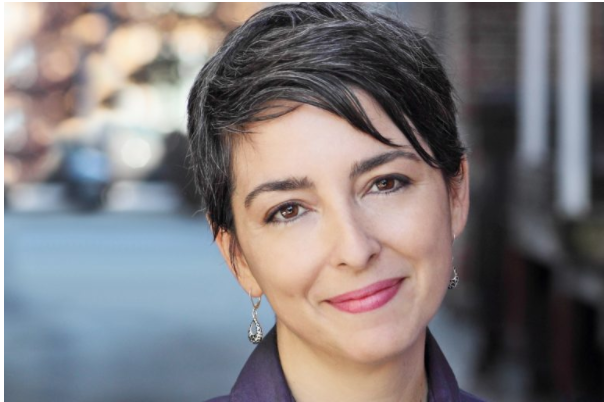The Last Castle: Q&A with Denise Kiernan
If you’ve visited the Biltmore Estate in Asheville, North Carolina, and think you know everything there is to know about the magnificent house and those that built it…think again! Denise Kiernan’s The Last Castle, a Bas Bleu Book a Month 2018 selection, offers readers a deeper dive into the fascinating history of the the Vanderbilt family, the brilliant minds that conceived and created Biltmore, and the major events and figures in America’s past that shaped it. Recently, Denise took a break from her writing schedule to share her inspiration, the lessons she’s learned from her writing life, and Biltmore’s role in the preservation of America’s natural resources.
Bas Bleu: You’ve written about the Founding Fathers and the women who worked at Oak Ridge during World War II. Why did you choose Biltmore as your next story to tell? Where do you even begin to research such a mammoth subject?
Denise Kiernan: I love writing what I consider to be “underappreciated history.” For the Declaration and Constitutions books that I wrote with my husband, Joseph D’Agnese, I enjoyed examining the lives of the many individuals involved in the founding of America who get very little—if any—attention today. The same is true in a way with [a Bas Bleu Book a Month 2014 selection] The Girls of Atomic City: while there had been books about the Manhattan Project, and a great deal written about the organizers, scientists and people in charge, I wanted to look at the dawn of the nuclear age through the eyes of very young women who were working in less glamorous positions, but nevertheless integral to the project itself. The Last Castle is quite similar. When we think of the height of the Gilded Age in American, and the lives of the Vanderbilts and Astors and others, we think of New York City and the luxurious cottages of Newport, Rhode Island. Yet the most remarkable home in the country—and in my opinion, some of the more fascinating people—was in Western North Carolina. The ways in which history at Biltmore House intersected with larger issues and trends in American life is very interesting to me. To get started on any project, no matter the size, I dig into the resources related to those topics or people that most capture my imagination. It gets me motivated. In this case, that motivation was Edith Vanderbilt.
BB: What was the most surprising thing you learned about Biltmore and/or the Vanderbilt family while researching this book?
DK: While it’s hard to choose any one thing, I continue to be amazed by the incredibly important role that Biltmore House and the Vanderbilt family played in the history of forestry in the United States. Biltmore was the home to the first ever school of forestry in America, and the work that was done on those extensive land holdings set the stage for a robust and healthy Pisgah National Forest, much of which is still intact today.
Denise Kiernan (photo credit: Treadshots.com)
BB: It was fascinating to read just how much influence George Vanderbilt and the Biltmore estate had over western North Carolina’s development, economy, and natural conservation. Do you think Asheville was a “company town” in the first half of the twentieth century?
DK: One of the more delightful tidbits that I gathered during research was hearing a little ditty that my friend Brenda Lilly’s father had learned from his father. “When I grow up, if I don’t get kilt, I wanna work for the Vanderbilts…” This, to me, showed just how much of a presence the house and its associated works—the dairy, etc.—had and still has in Asheville. Asheville was already a destination for visitors before the house was built, though. In a way, you could say that Asheville is still a company town. Biltmore is a huge employer to this day and certainly a major tourist attraction.
BB: While Edith Vanderbilt’s youth was not without its challenges, by most standards she lived a very privileged life. And yet she—and later her daughter Cornelia—managed to scrap and deal and ultimately hold on to (most of) Biltmore at a time when fortunes were failing and many of the other Gilded Age estates were being sold off. If Edith and Cornelia were transported to 2018, how do you think they would put their skills to use?
DK: That is a fantastic question! I have to imagine that they would be involved in some sort of philanthropic undertaking. Both women were so very giving in so many ways, both on a personal level as well as financially. I would like to think that Edith might be involved in local politics. I could absolutely see both of them playing roles in the thriving local agriculture scene in Asheville as well, definitely getting behind the “buy local” movement. Despite their backgrounds and privilege, I see them as rather down-to-earth in many ways.
BB: Cornelia ultimately left Biltmore and built a new life in Europe. Ironically, it was her English husband, John Cecil, who stayed in North Carolina to nurture the estate, eventually bringing their sons into the family business. (Biltmore is still held by the Cecil family today.) Were you surprised that Cornelia broke away from Biltmore, the place to which her parents were so devoted?
DK: You know, the more I work as a writer—it’s more than twenty years now that I’ve been doing this—and the more that I delve into people’s lives, there is very little that surprises me about human behavior. We are all driven by so many factors in our lives. If I look back on my life, where I am now doesn’t make a whole lot of sense! Perhaps Cornelia’s exposure to this beautiful, rural area of Western North Carolina and the people who lived here made her long for something simpler. Maybe all the attention she received as a Vanderbilt was eventually too much, and felt too smothering. It’s hard to say. I do find her fascinating, and remain impressed at the philanthropic activities she engaged in throughout her life. I think perhaps most of all she got that from her parents, that desire to help others.
BB: Aside from tourism revenue, what is the most lasting contribution you think the Vanderbilts made by establishing the Biltmore estate?
DK: I think it’s interesting that when we think of Biltmore we obviously think of the house, this amazing structure. But I actually believe that the most lasting and perhaps significant part of the Vanderbilt legacy in Western North Carolina is not what was built, but rather what was not built: the rehabilitation and preservation of so much of the surrounding forests.
BB: The Vanderbilts and their social circle were the 1% of the Gilded Age, both admired and vilified by the celebrity watchers of their time. Even when raging against income inequity, why do you think Americans remain so fascinated by the lifestyles of the rich and famous?
DK: That fascination is one of the reasons that I wanted to do this book. I kept thinking of all the modern-day relevance I saw when I compared the gossip-page fodder of the Gilded Age to the celebrity-stalking of today. There seems to be an insatiable appetite for details about the lives of the wealthy and privileged. I think on some level it can be aspirational, but in the end I think it can also be damaging if too much time and energy is focused on what one doesn’t have in their own life.
BB: You currently live in Asheville. What brought you there? How do you perceive the locals feel about their “castle?” And how do you explain Biltmore’s power to draw visitors from around the world to a small (if lovely!) city tucked in the Blue Ridge Mountains, away from our country’s other international destinations like New York, Orlando, or Las Vegas?
DK: This post is in no way long enough to get into how we landed in Asheville twelve years ago! It is a very circuitous tale—there was no one, specific reason we moved here. However, we are not unusual. There are a lot of “transplants” that come here, especially from larger cities. Most people I know here love the house and grounds and go often, as we do. I think Asheville’s natural beauty is definitely a draw. There is a lot of good hiking and climbing and kayaking—that’s my favorite—while there are still fantastic independent restaurants, shops and entertainment. The downtown has also remained mostly intact, so it is a lovely, manageable place to visit and stroll.
BB: Which book(s) from your childhood helped to shape the person you are today?
DK: That’s a tough one, but some that come to mind include From the Mixed Up Files of Mrs. Basil E. Frankweiler, The Hobbit, and the Encyclopedia Brown series.
BB: Aside from your own titles, which books are you quick to recommend to other readers?
DK: Liar, Temptress, Soldier, Spy by Karen Abbott [a Bas Bleu Book a Month 2015 pick] and Marshal of the Borgo by my husband, Joseph D’Agnese.
BB: What future projects can our readers look forward to seeing from you?
DK: Without getting into too many specifics—because I rarely do in the early stages of any book—I am working on another narrative nonfiction history, this one takes place earlier on in American history than The Last Castle. As always, there are real-life characters who I think played a larger role in history than has yet to be fully appreciated. Hopefully I can do them justice.
BB: Many thanks to Denise for sharing her insights…and for her books that introduce us to so many fascinating figures from American history!

